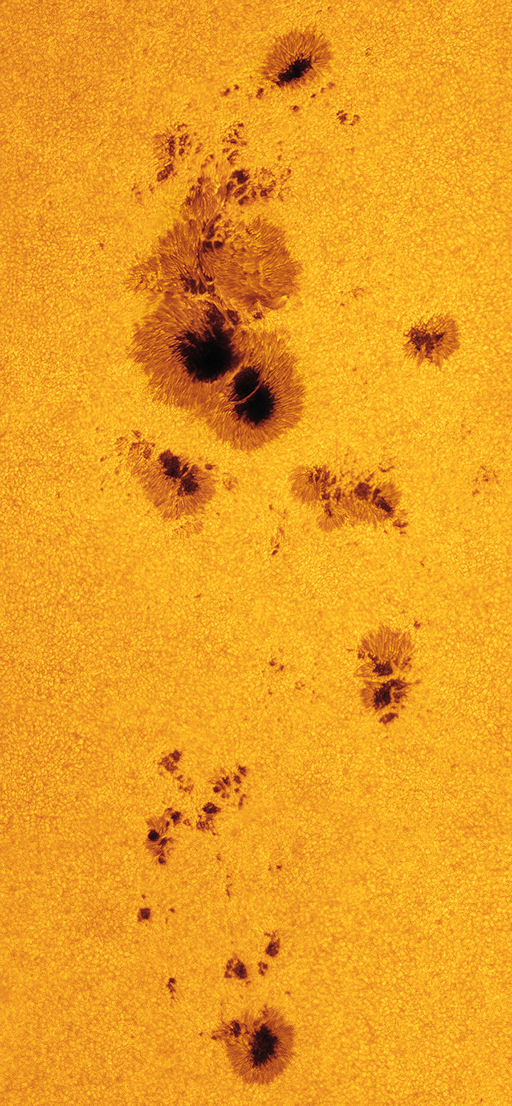POISED TO EXPLODE? Big sunspot AR1520 has been relatively quiet for the past 24 hours, but this could be the calm before the storm. The sunspot has a delta-class magnetic field that harbors energy for X-class solar flares. Solar flare alerts: text, voice.
MORNING PLANETS: Set your alarm for dawn. Jupiter and Venus have lined up in the eastern sky for a beautiful pre-dawn conjunction. Paul Martini photographed the gathering on July 10th from California's Joshua Tree National Park:
"I caught Jupiter, Venus, and the Pleiades rising above the adobe ruins of the Ryan Ranch, which was built in the 19th century," says Martini.
As beautiful as it is now, the show is about to get even better. On July 15th a slender crescent Moon, alight with the Da Vinci glow, will join Jupiter and Venus to form a bright celestial triangle in the morning sky. Don't miss it!
Realtime Planets Photo Gallery
[NASA video: A Good Reason to Wake Up at Dawn]
SOLAR ARCHIPELAGO: Sunspots are magnetic islands on the sun. Sunspot AR1520 is a complete archipelago. Scroll down to scan more than 200,000 miles of island chain:
Amateur astronomer Alan Friedman took the picture on July 10th from his backyard observatory in Buffalo, New York. "AR1520 is a tremendous archipelago and a wonderful target for backyard solar telescopes," he says.
The tangled magnetic canopy of the sunspot group, shown here in an extreme UV images from NASA's Solar Dynamics Observatory, harbors energy for strong solar flares. NOAA forecasters estimate an 80% chance of M-class flares and a 15% chance of X-class flares during the next 24 hours. Solar flare alerts: text, voice.

![]()
Solar wind
speed: 477.2 km/sec
density: 0.0 protons/cm3
explanation | more data
Updated: Today at 1551 UT
![]()
X-ray Solar Flares
6-hr max: C1 1442 UT Jul11
24-hr: C9 0831 UT Jul11
explanation | more data
Updated: Today at: 1600 UT
![]()
![]()
![]()
Daily Sun: 11 Jul 12
![]()
![]()
Sunspot 1520 has a delta-class magnetic field that harbors energy for X-class solar flares. Credit: SDO/HMI
![]()
![]()
![]()
Sunspot number: 122
What is the sunspot number?
Updated 11 Jul 2012
Spotless Days
Current Stretch: 0 days
2012 total: 0 days (0%)
2011 total: 2 days (<1%)
2010 total: 51 days (14%)
2009 total: 260 days (71%)
Since 2004: 821 days
Typical Solar Min: 486 days
Updated 11 Jul 2012
The Radio Sun
10.7 cm flux: 173 sfu
explanation | more data
Updated 11 Jul 2012
![]()
![]()
![]()
Current Auroral Oval:
![]()
Switch to: Europe, USA, New Zealand, Antarctica
Credit: NOAA/POES
![]()
![]()
![]()
Planetary K-index
Now: Kp= 1 quiet
24-hr max: Kp= 3 quiet
explanation | more data
![]()
Interplanetary Mag. Field
Btotal: 5.2 nT
Bz: 1.8 nT south
explanation | more data
Updated: Today at 1556 UT
![]()
![]()
![]()
Coronal Holes: 09 Jul 12
![]()
![]()
A solar wind stream flowing from the indicated coronal hole cold reach Earth on July 10-11. Credit: SDO/AIA.






